Assessment 5: Developing an Inclusion Plan for Child Taya's Needs
VerifiedAdded on 2020/03/01
|17
|2560
|39
Report
AI Summary
This report, part of an assessment, focuses on developing an inclusion plan for a 3-year-old girl named Taya, who faces learning difficulties due to shyness and non-verbal communication barriers. The report begins with an introduction to Taya's challenges, including her limited interactions and stammering. It then details an information sheet summarizing observations from the child, family, and staff, highlighting the implications for planning. Ethical considerations regarding child research are addressed, followed by three key observations analyzing Taya's shyness, stammering, and lack of eye contact. The report includes a learning and development summary, outlining Taya's weaknesses and strengths, and proposes speech and play therapy interventions. Finally, it presents an inclusion plan format, defining the barrier to learning, strategies for family support, and both short-term objectives and long-term goals, along with environmental modifications and evaluation methods. The plan emphasizes the importance of speech and play therapy, and the role of teachers, staff and parents in supporting Taya's development.
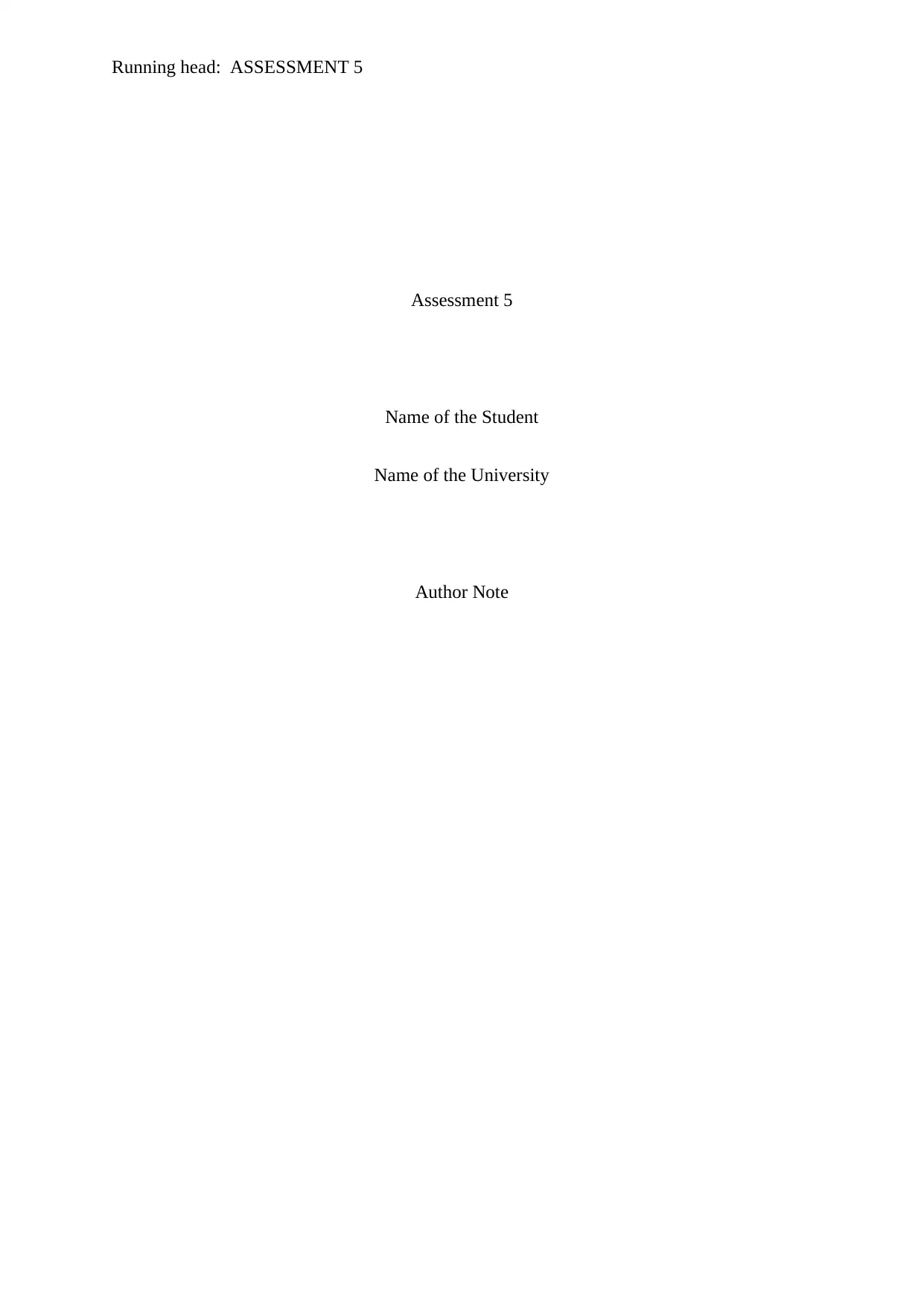
Running head: ASSESSMENT 5
Assessment 5
Name of the Student
Name of the University
Author Note
Assessment 5
Name of the Student
Name of the University
Author Note
Paraphrase This Document
Need a fresh take? Get an instant paraphrase of this document with our AI Paraphraser
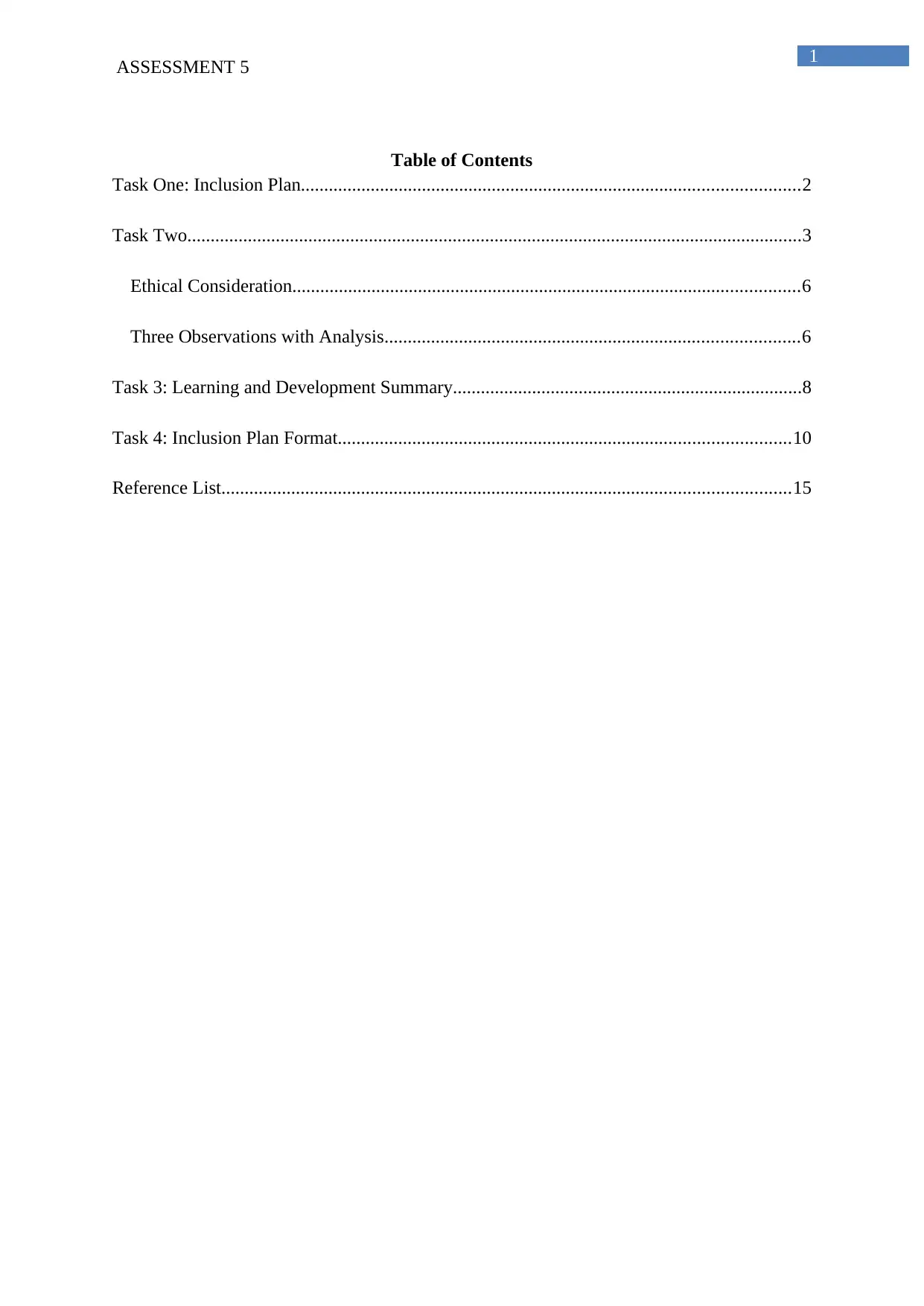
1
ASSESSMENT 5
Table of Contents
Task One: Inclusion Plan...........................................................................................................2
Task Two....................................................................................................................................3
Ethical Consideration.............................................................................................................6
Three Observations with Analysis.........................................................................................6
Task 3: Learning and Development Summary...........................................................................8
Task 4: Inclusion Plan Format.................................................................................................10
Reference List..........................................................................................................................15
ASSESSMENT 5
Table of Contents
Task One: Inclusion Plan...........................................................................................................2
Task Two....................................................................................................................................3
Ethical Consideration.............................................................................................................6
Three Observations with Analysis.........................................................................................6
Task 3: Learning and Development Summary...........................................................................8
Task 4: Inclusion Plan Format.................................................................................................10
Reference List..........................................................................................................................15
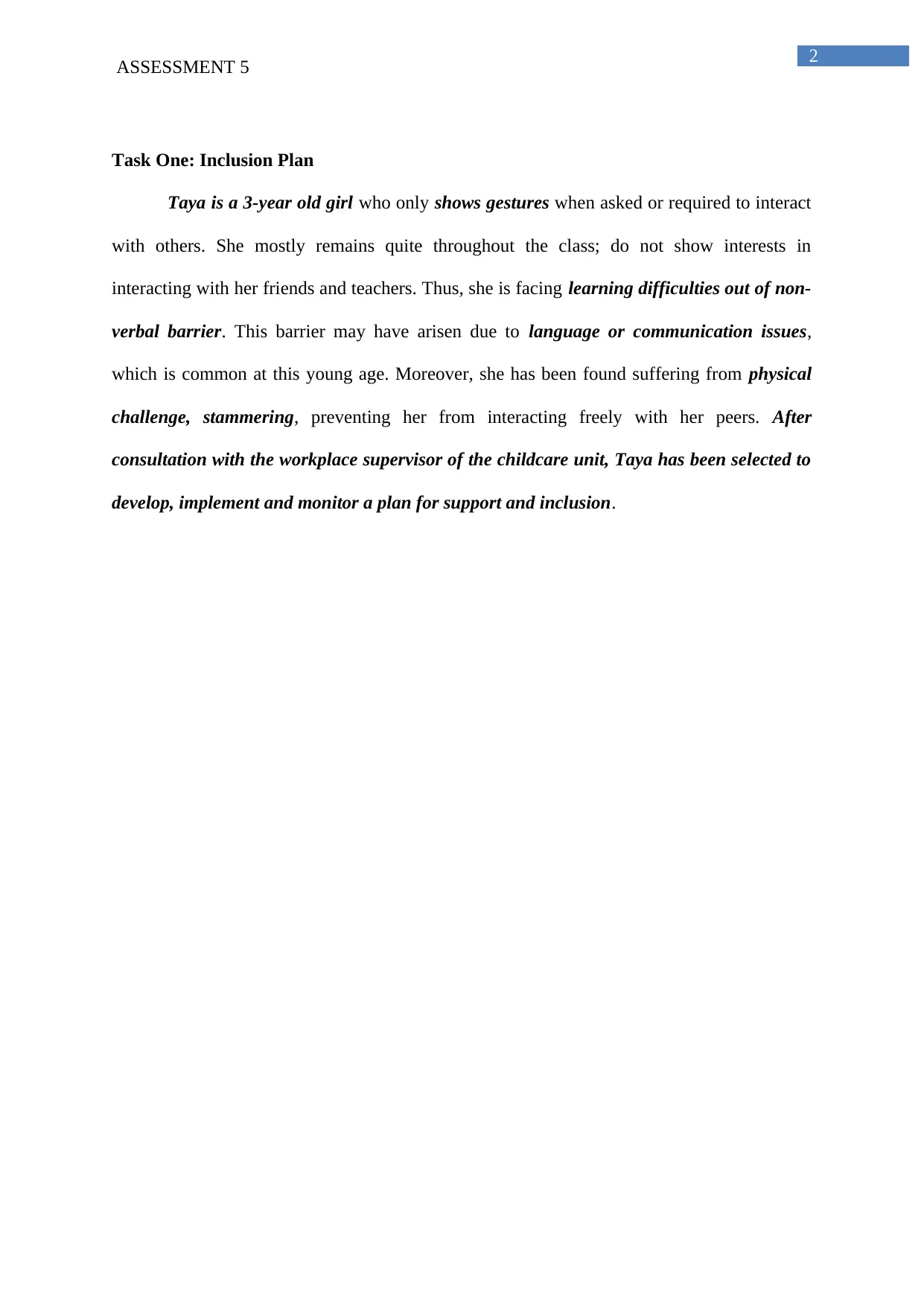
2
ASSESSMENT 5
Task One: Inclusion Plan
Taya is a 3-year old girl who only shows gestures when asked or required to interact
with others. She mostly remains quite throughout the class; do not show interests in
interacting with her friends and teachers. Thus, she is facing learning difficulties out of non-
verbal barrier. This barrier may have arisen due to language or communication issues,
which is common at this young age. Moreover, she has been found suffering from physical
challenge, stammering, preventing her from interacting freely with her peers. After
consultation with the workplace supervisor of the childcare unit, Taya has been selected to
develop, implement and monitor a plan for support and inclusion.
ASSESSMENT 5
Task One: Inclusion Plan
Taya is a 3-year old girl who only shows gestures when asked or required to interact
with others. She mostly remains quite throughout the class; do not show interests in
interacting with her friends and teachers. Thus, she is facing learning difficulties out of non-
verbal barrier. This barrier may have arisen due to language or communication issues,
which is common at this young age. Moreover, she has been found suffering from physical
challenge, stammering, preventing her from interacting freely with her peers. After
consultation with the workplace supervisor of the childcare unit, Taya has been selected to
develop, implement and monitor a plan for support and inclusion.
⊘ This is a preview!⊘
Do you want full access?
Subscribe today to unlock all pages.

Trusted by 1+ million students worldwide
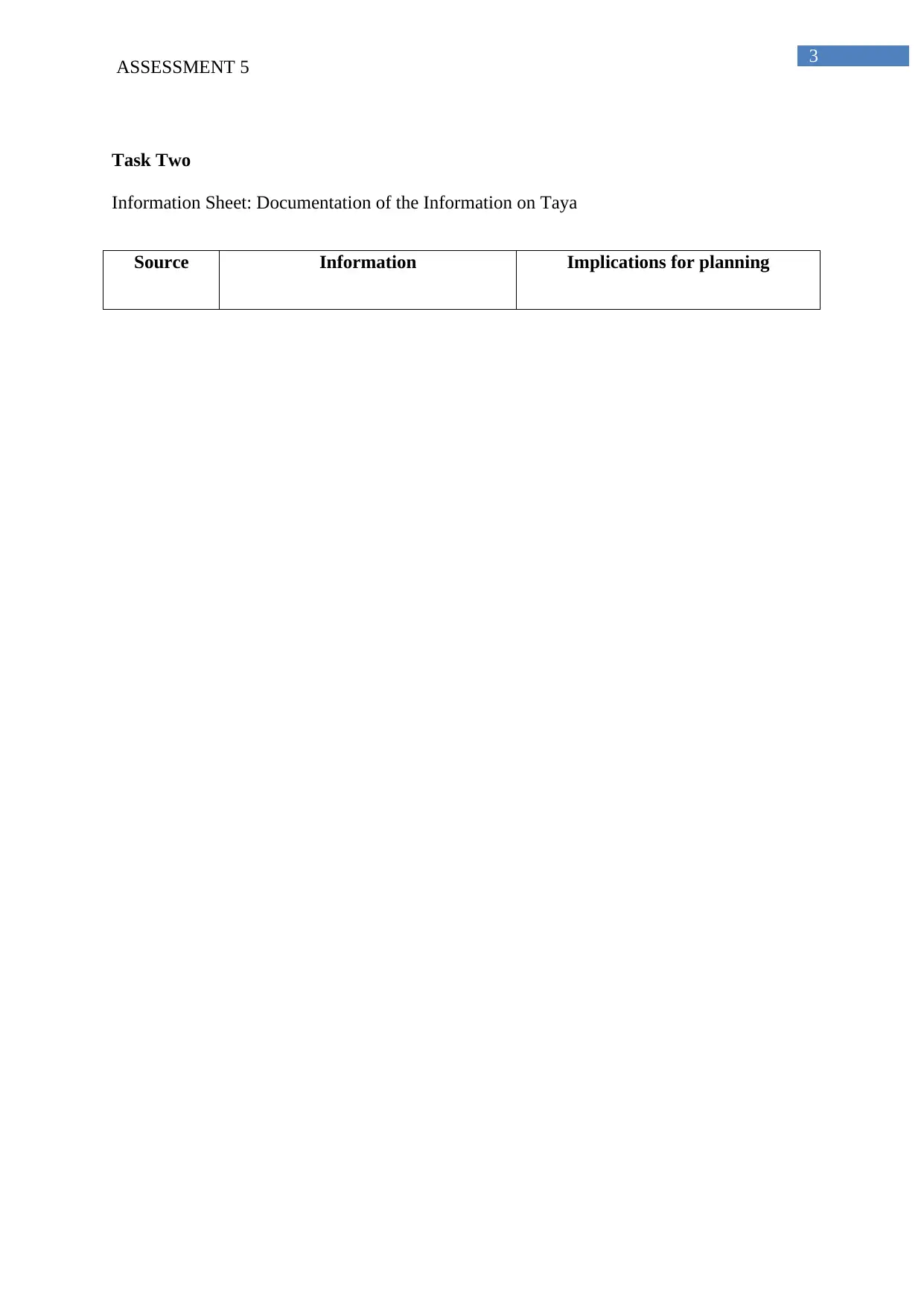
3
ASSESSMENT 5
Task Two
Information Sheet: Documentation of the Information on Taya
Source Information Implications for planning
ASSESSMENT 5
Task Two
Information Sheet: Documentation of the Information on Taya
Source Information Implications for planning
Paraphrase This Document
Need a fresh take? Get an instant paraphrase of this document with our AI Paraphraser
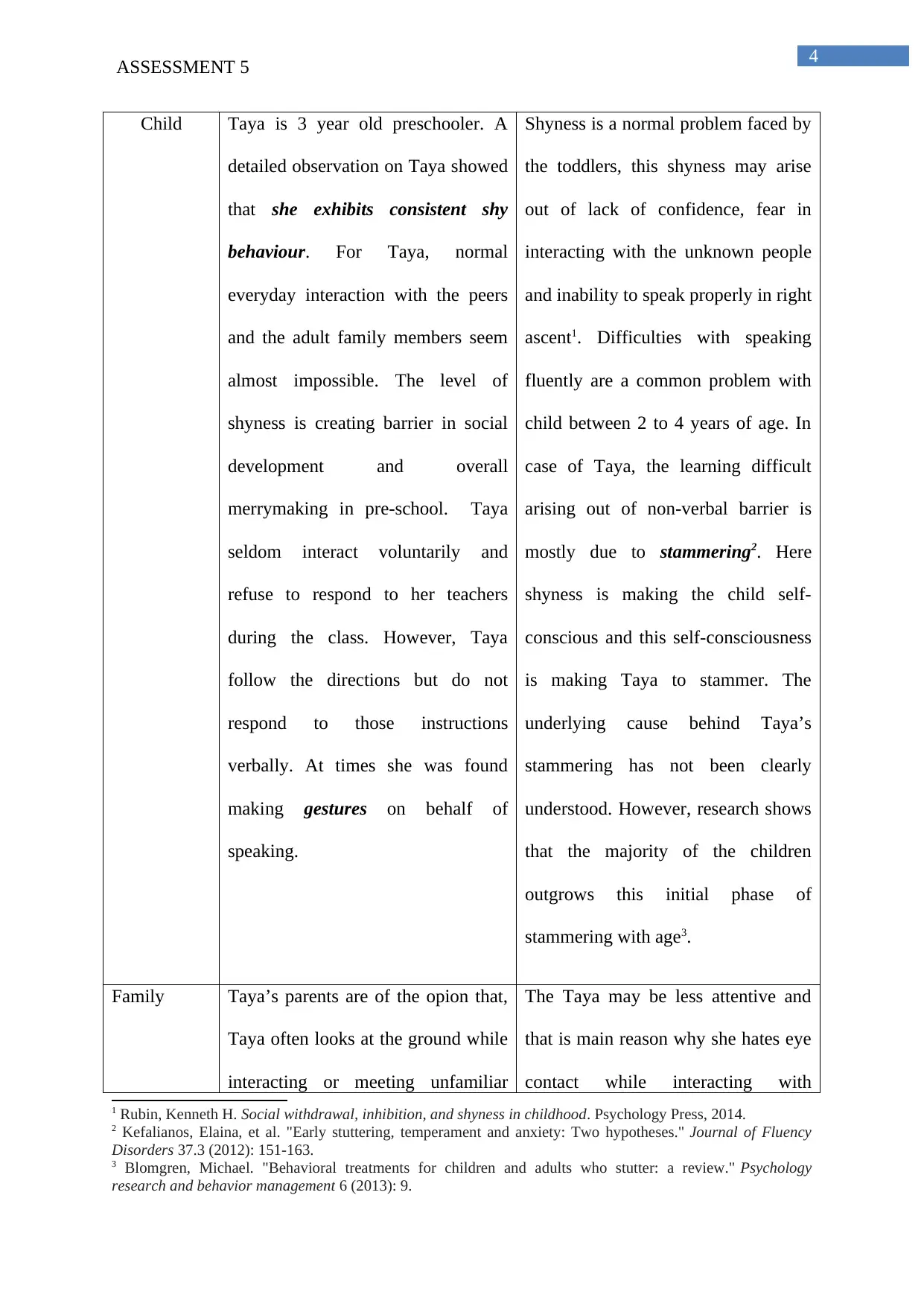
4
ASSESSMENT 5
Child Taya is 3 year old preschooler. A
detailed observation on Taya showed
that she exhibits consistent shy
behaviour. For Taya, normal
everyday interaction with the peers
and the adult family members seem
almost impossible. The level of
shyness is creating barrier in social
development and overall
merrymaking in pre-school. Taya
seldom interact voluntarily and
refuse to respond to her teachers
during the class. However, Taya
follow the directions but do not
respond to those instructions
verbally. At times she was found
making gestures on behalf of
speaking.
Shyness is a normal problem faced by
the toddlers, this shyness may arise
out of lack of confidence, fear in
interacting with the unknown people
and inability to speak properly in right
ascent1. Difficulties with speaking
fluently are a common problem with
child between 2 to 4 years of age. In
case of Taya, the learning difficult
arising out of non-verbal barrier is
mostly due to stammering2. Here
shyness is making the child self-
conscious and this self-consciousness
is making Taya to stammer. The
underlying cause behind Taya’s
stammering has not been clearly
understood. However, research shows
that the majority of the children
outgrows this initial phase of
stammering with age3.
Family Taya’s parents are of the opion that,
Taya often looks at the ground while
interacting or meeting unfamiliar
The Taya may be less attentive and
that is main reason why she hates eye
contact while interacting with
1 Rubin, Kenneth H. Social withdrawal, inhibition, and shyness in childhood. Psychology Press, 2014.
2 Kefalianos, Elaina, et al. "Early stuttering, temperament and anxiety: Two hypotheses." Journal of Fluency
Disorders 37.3 (2012): 151-163.
3 Blomgren, Michael. "Behavioral treatments for children and adults who stutter: a review." Psychology
research and behavior management 6 (2013): 9.
ASSESSMENT 5
Child Taya is 3 year old preschooler. A
detailed observation on Taya showed
that she exhibits consistent shy
behaviour. For Taya, normal
everyday interaction with the peers
and the adult family members seem
almost impossible. The level of
shyness is creating barrier in social
development and overall
merrymaking in pre-school. Taya
seldom interact voluntarily and
refuse to respond to her teachers
during the class. However, Taya
follow the directions but do not
respond to those instructions
verbally. At times she was found
making gestures on behalf of
speaking.
Shyness is a normal problem faced by
the toddlers, this shyness may arise
out of lack of confidence, fear in
interacting with the unknown people
and inability to speak properly in right
ascent1. Difficulties with speaking
fluently are a common problem with
child between 2 to 4 years of age. In
case of Taya, the learning difficult
arising out of non-verbal barrier is
mostly due to stammering2. Here
shyness is making the child self-
conscious and this self-consciousness
is making Taya to stammer. The
underlying cause behind Taya’s
stammering has not been clearly
understood. However, research shows
that the majority of the children
outgrows this initial phase of
stammering with age3.
Family Taya’s parents are of the opion that,
Taya often looks at the ground while
interacting or meeting unfamiliar
The Taya may be less attentive and
that is main reason why she hates eye
contact while interacting with
1 Rubin, Kenneth H. Social withdrawal, inhibition, and shyness in childhood. Psychology Press, 2014.
2 Kefalianos, Elaina, et al. "Early stuttering, temperament and anxiety: Two hypotheses." Journal of Fluency
Disorders 37.3 (2012): 151-163.
3 Blomgren, Michael. "Behavioral treatments for children and adults who stutter: a review." Psychology
research and behavior management 6 (2013): 9.
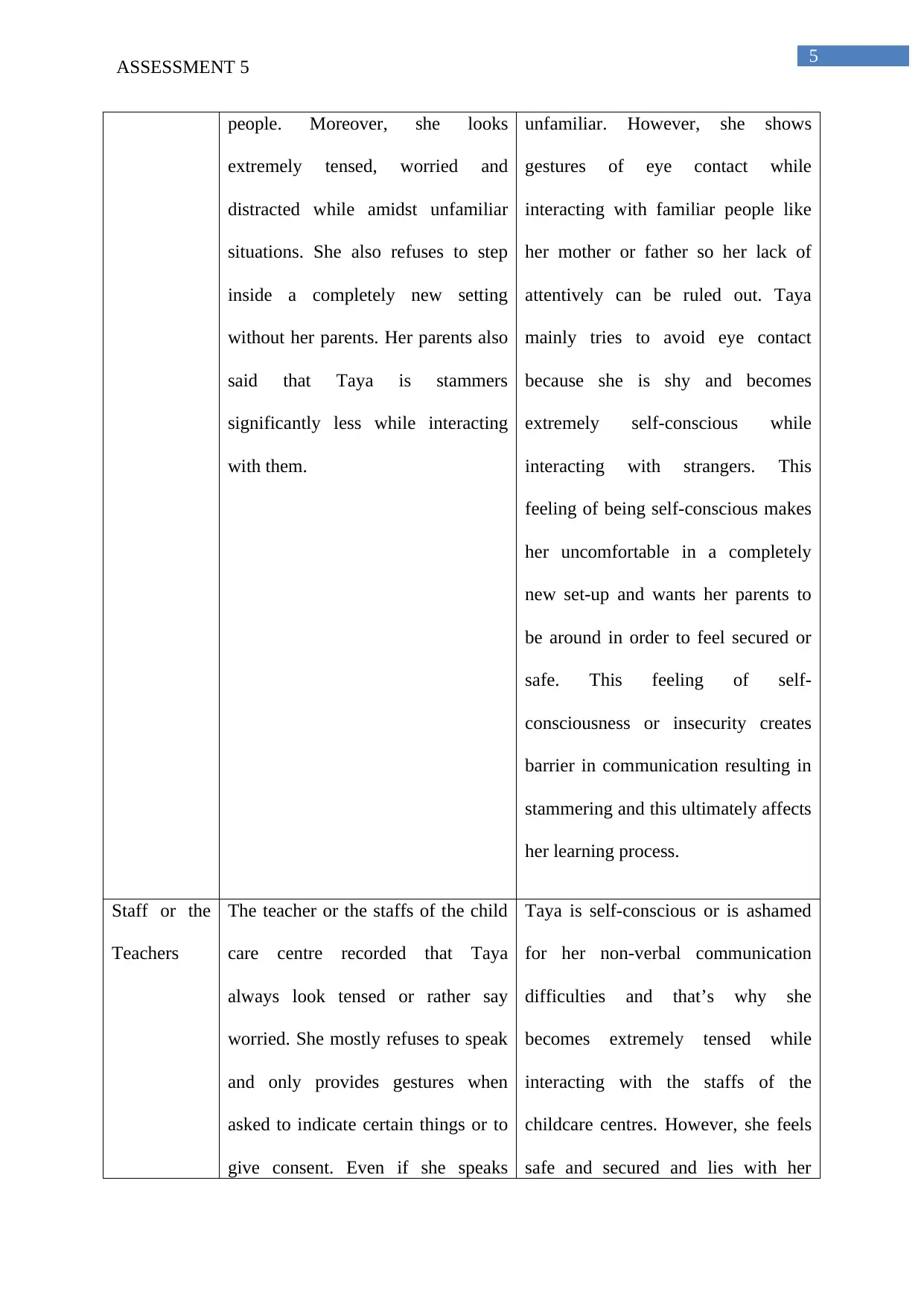
5
ASSESSMENT 5
people. Moreover, she looks
extremely tensed, worried and
distracted while amidst unfamiliar
situations. She also refuses to step
inside a completely new setting
without her parents. Her parents also
said that Taya is stammers
significantly less while interacting
with them.
unfamiliar. However, she shows
gestures of eye contact while
interacting with familiar people like
her mother or father so her lack of
attentively can be ruled out. Taya
mainly tries to avoid eye contact
because she is shy and becomes
extremely self-conscious while
interacting with strangers. This
feeling of being self-conscious makes
her uncomfortable in a completely
new set-up and wants her parents to
be around in order to feel secured or
safe. This feeling of self-
consciousness or insecurity creates
barrier in communication resulting in
stammering and this ultimately affects
her learning process.
Staff or the
Teachers
The teacher or the staffs of the child
care centre recorded that Taya
always look tensed or rather say
worried. She mostly refuses to speak
and only provides gestures when
asked to indicate certain things or to
give consent. Even if she speaks
Taya is self-conscious or is ashamed
for her non-verbal communication
difficulties and that’s why she
becomes extremely tensed while
interacting with the staffs of the
childcare centres. However, she feels
safe and secured and lies with her
ASSESSMENT 5
people. Moreover, she looks
extremely tensed, worried and
distracted while amidst unfamiliar
situations. She also refuses to step
inside a completely new setting
without her parents. Her parents also
said that Taya is stammers
significantly less while interacting
with them.
unfamiliar. However, she shows
gestures of eye contact while
interacting with familiar people like
her mother or father so her lack of
attentively can be ruled out. Taya
mainly tries to avoid eye contact
because she is shy and becomes
extremely self-conscious while
interacting with strangers. This
feeling of being self-conscious makes
her uncomfortable in a completely
new set-up and wants her parents to
be around in order to feel secured or
safe. This feeling of self-
consciousness or insecurity creates
barrier in communication resulting in
stammering and this ultimately affects
her learning process.
Staff or the
Teachers
The teacher or the staffs of the child
care centre recorded that Taya
always look tensed or rather say
worried. She mostly refuses to speak
and only provides gestures when
asked to indicate certain things or to
give consent. Even if she speaks
Taya is self-conscious or is ashamed
for her non-verbal communication
difficulties and that’s why she
becomes extremely tensed while
interacting with the staffs of the
childcare centres. However, she feels
safe and secured and lies with her
⊘ This is a preview!⊘
Do you want full access?
Subscribe today to unlock all pages.

Trusted by 1+ million students worldwide
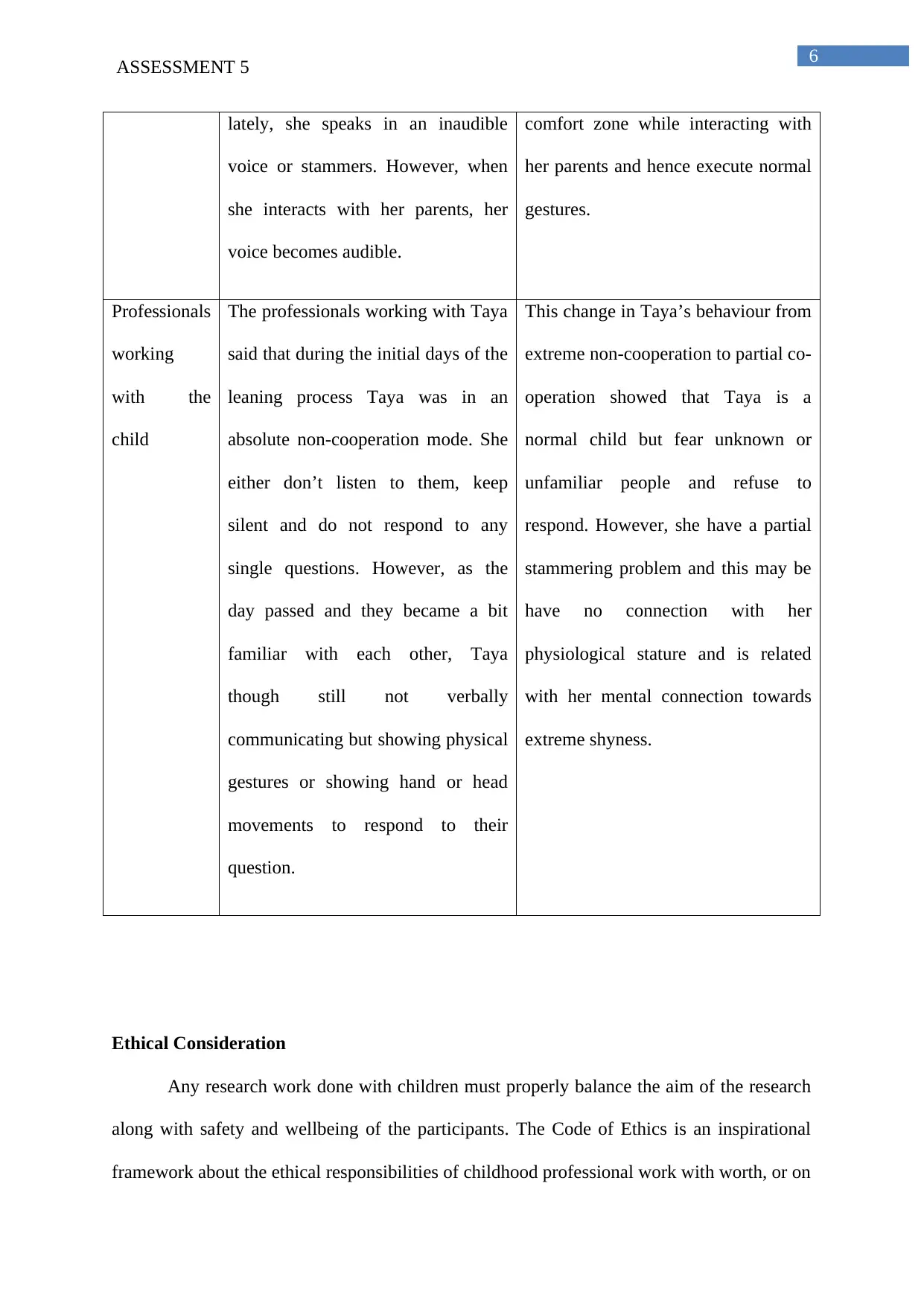
6
ASSESSMENT 5
lately, she speaks in an inaudible
voice or stammers. However, when
she interacts with her parents, her
voice becomes audible.
comfort zone while interacting with
her parents and hence execute normal
gestures.
Professionals
working
with the
child
The professionals working with Taya
said that during the initial days of the
leaning process Taya was in an
absolute non-cooperation mode. She
either don’t listen to them, keep
silent and do not respond to any
single questions. However, as the
day passed and they became a bit
familiar with each other, Taya
though still not verbally
communicating but showing physical
gestures or showing hand or head
movements to respond to their
question.
This change in Taya’s behaviour from
extreme non-cooperation to partial co-
operation showed that Taya is a
normal child but fear unknown or
unfamiliar people and refuse to
respond. However, she have a partial
stammering problem and this may be
have no connection with her
physiological stature and is related
with her mental connection towards
extreme shyness.
Ethical Consideration
Any research work done with children must properly balance the aim of the research
along with safety and wellbeing of the participants. The Code of Ethics is an inspirational
framework about the ethical responsibilities of childhood professional work with worth, or on
ASSESSMENT 5
lately, she speaks in an inaudible
voice or stammers. However, when
she interacts with her parents, her
voice becomes audible.
comfort zone while interacting with
her parents and hence execute normal
gestures.
Professionals
working
with the
child
The professionals working with Taya
said that during the initial days of the
leaning process Taya was in an
absolute non-cooperation mode. She
either don’t listen to them, keep
silent and do not respond to any
single questions. However, as the
day passed and they became a bit
familiar with each other, Taya
though still not verbally
communicating but showing physical
gestures or showing hand or head
movements to respond to their
question.
This change in Taya’s behaviour from
extreme non-cooperation to partial co-
operation showed that Taya is a
normal child but fear unknown or
unfamiliar people and refuse to
respond. However, she have a partial
stammering problem and this may be
have no connection with her
physiological stature and is related
with her mental connection towards
extreme shyness.
Ethical Consideration
Any research work done with children must properly balance the aim of the research
along with safety and wellbeing of the participants. The Code of Ethics is an inspirational
framework about the ethical responsibilities of childhood professional work with worth, or on
Paraphrase This Document
Need a fresh take? Get an instant paraphrase of this document with our AI Paraphraser
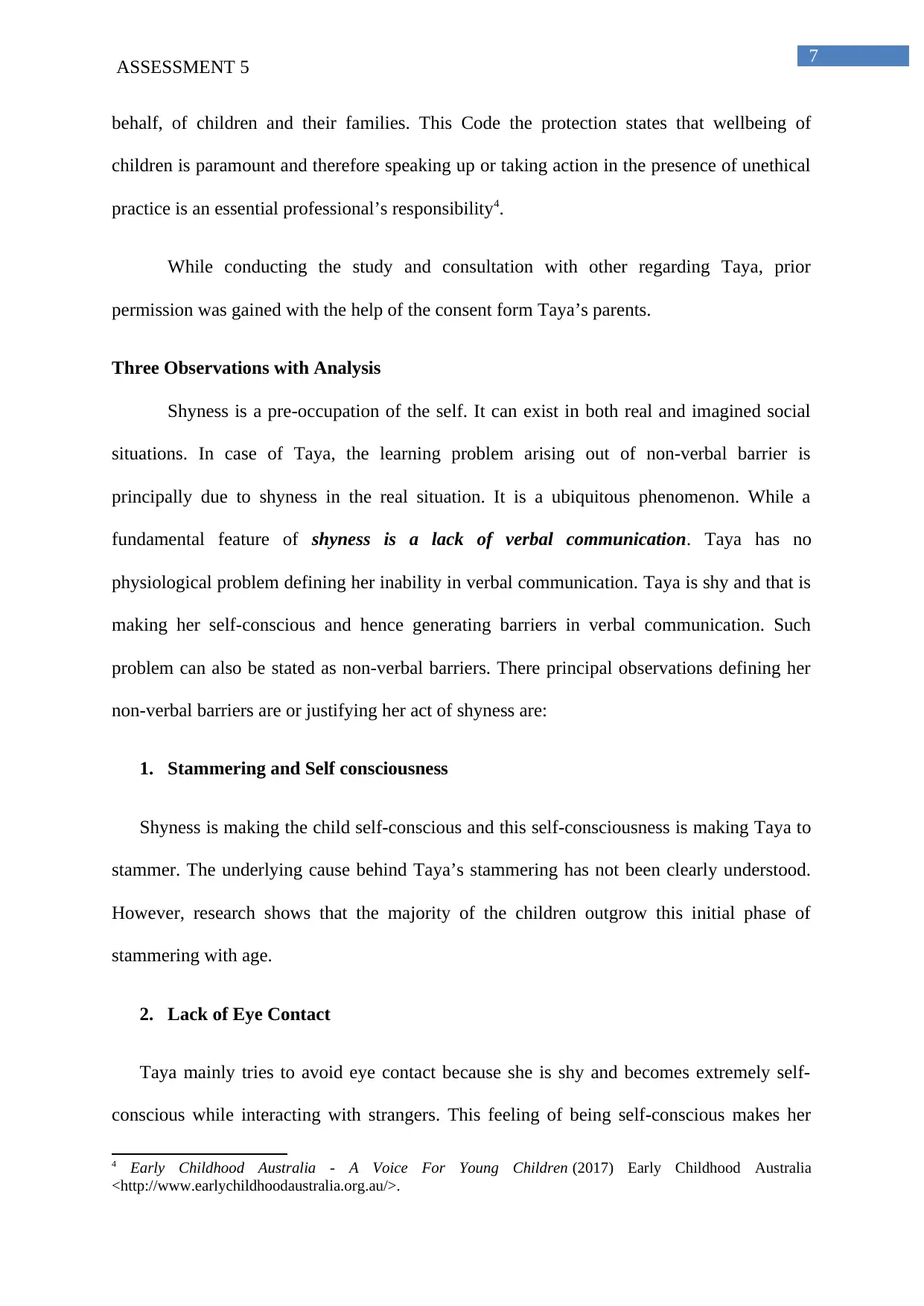
7
ASSESSMENT 5
behalf, of children and their families. This Code the protection states that wellbeing of
children is paramount and therefore speaking up or taking action in the presence of unethical
practice is an essential professional’s responsibility4.
While conducting the study and consultation with other regarding Taya, prior
permission was gained with the help of the consent form Taya’s parents.
Three Observations with Analysis
Shyness is a pre-occupation of the self. It can exist in both real and imagined social
situations. In case of Taya, the learning problem arising out of non-verbal barrier is
principally due to shyness in the real situation. It is a ubiquitous phenomenon. While a
fundamental feature of shyness is a lack of verbal communication. Taya has no
physiological problem defining her inability in verbal communication. Taya is shy and that is
making her self-conscious and hence generating barriers in verbal communication. Such
problem can also be stated as non-verbal barriers. There principal observations defining her
non-verbal barriers are or justifying her act of shyness are:
1. Stammering and Self consciousness
Shyness is making the child self-conscious and this self-consciousness is making Taya to
stammer. The underlying cause behind Taya’s stammering has not been clearly understood.
However, research shows that the majority of the children outgrow this initial phase of
stammering with age.
2. Lack of Eye Contact
Taya mainly tries to avoid eye contact because she is shy and becomes extremely self-
conscious while interacting with strangers. This feeling of being self-conscious makes her
4 Early Childhood Australia - A Voice For Young Children (2017) Early Childhood Australia
<http://www.earlychildhoodaustralia.org.au/>.
ASSESSMENT 5
behalf, of children and their families. This Code the protection states that wellbeing of
children is paramount and therefore speaking up or taking action in the presence of unethical
practice is an essential professional’s responsibility4.
While conducting the study and consultation with other regarding Taya, prior
permission was gained with the help of the consent form Taya’s parents.
Three Observations with Analysis
Shyness is a pre-occupation of the self. It can exist in both real and imagined social
situations. In case of Taya, the learning problem arising out of non-verbal barrier is
principally due to shyness in the real situation. It is a ubiquitous phenomenon. While a
fundamental feature of shyness is a lack of verbal communication. Taya has no
physiological problem defining her inability in verbal communication. Taya is shy and that is
making her self-conscious and hence generating barriers in verbal communication. Such
problem can also be stated as non-verbal barriers. There principal observations defining her
non-verbal barriers are or justifying her act of shyness are:
1. Stammering and Self consciousness
Shyness is making the child self-conscious and this self-consciousness is making Taya to
stammer. The underlying cause behind Taya’s stammering has not been clearly understood.
However, research shows that the majority of the children outgrow this initial phase of
stammering with age.
2. Lack of Eye Contact
Taya mainly tries to avoid eye contact because she is shy and becomes extremely self-
conscious while interacting with strangers. This feeling of being self-conscious makes her
4 Early Childhood Australia - A Voice For Young Children (2017) Early Childhood Australia
<http://www.earlychildhoodaustralia.org.au/>.
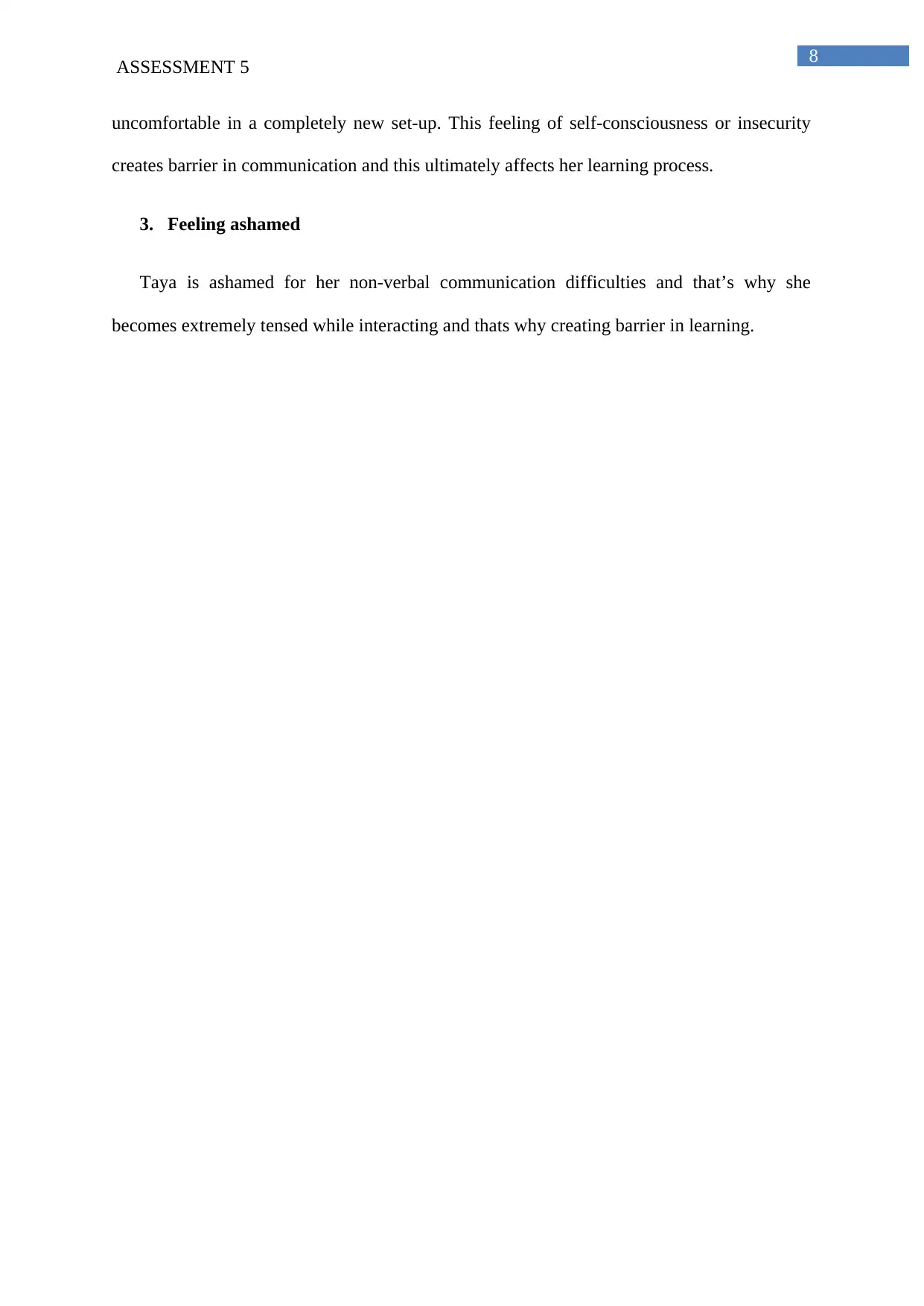
8
ASSESSMENT 5
uncomfortable in a completely new set-up. This feeling of self-consciousness or insecurity
creates barrier in communication and this ultimately affects her learning process.
3. Feeling ashamed
Taya is ashamed for her non-verbal communication difficulties and that’s why she
becomes extremely tensed while interacting and thats why creating barrier in learning.
ASSESSMENT 5
uncomfortable in a completely new set-up. This feeling of self-consciousness or insecurity
creates barrier in communication and this ultimately affects her learning process.
3. Feeling ashamed
Taya is ashamed for her non-verbal communication difficulties and that’s why she
becomes extremely tensed while interacting and thats why creating barrier in learning.
⊘ This is a preview!⊘
Do you want full access?
Subscribe today to unlock all pages.

Trusted by 1+ million students worldwide
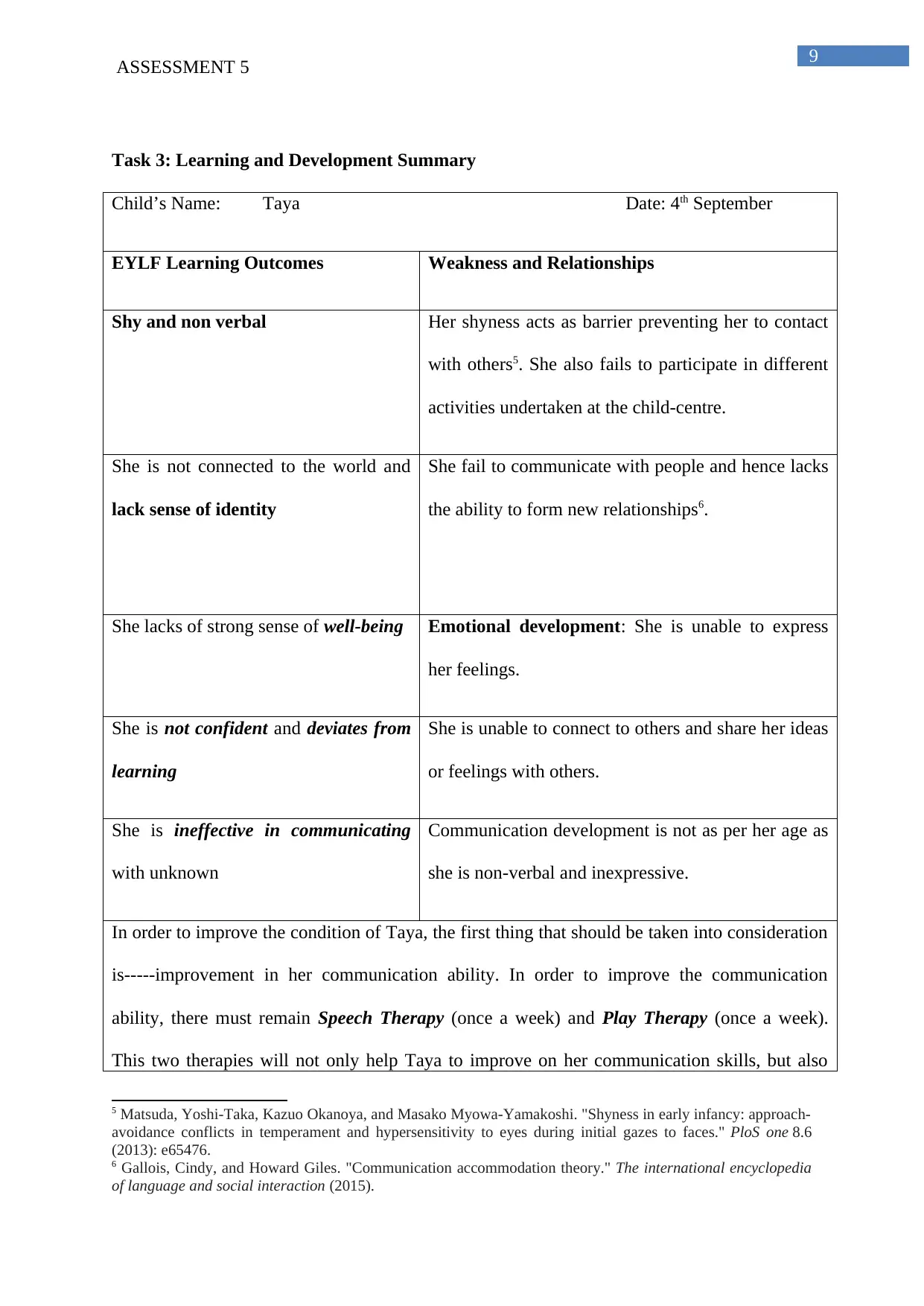
9
ASSESSMENT 5
Task 3: Learning and Development Summary
Child’s Name: Taya Date: 4th September
EYLF Learning Outcomes Weakness and Relationships
Shy and non verbal Her shyness acts as barrier preventing her to contact
with others5. She also fails to participate in different
activities undertaken at the child-centre.
She is not connected to the world and
lack sense of identity
She fail to communicate with people and hence lacks
the ability to form new relationships6.
She lacks of strong sense of well-being Emotional development: She is unable to express
her feelings.
She is not confident and deviates from
learning
She is unable to connect to others and share her ideas
or feelings with others.
She is ineffective in communicating
with unknown
Communication development is not as per her age as
she is non-verbal and inexpressive.
In order to improve the condition of Taya, the first thing that should be taken into consideration
is-----improvement in her communication ability. In order to improve the communication
ability, there must remain Speech Therapy (once a week) and Play Therapy (once a week).
This two therapies will not only help Taya to improve on her communication skills, but also
5 Matsuda, Yoshi-Taka, Kazuo Okanoya, and Masako Myowa-Yamakoshi. "Shyness in early infancy: approach-
avoidance conflicts in temperament and hypersensitivity to eyes during initial gazes to faces." PloS one 8.6
(2013): e65476.
6 Gallois, Cindy, and Howard Giles. "Communication accommodation theory." The international encyclopedia
of language and social interaction (2015).
ASSESSMENT 5
Task 3: Learning and Development Summary
Child’s Name: Taya Date: 4th September
EYLF Learning Outcomes Weakness and Relationships
Shy and non verbal Her shyness acts as barrier preventing her to contact
with others5. She also fails to participate in different
activities undertaken at the child-centre.
She is not connected to the world and
lack sense of identity
She fail to communicate with people and hence lacks
the ability to form new relationships6.
She lacks of strong sense of well-being Emotional development: She is unable to express
her feelings.
She is not confident and deviates from
learning
She is unable to connect to others and share her ideas
or feelings with others.
She is ineffective in communicating
with unknown
Communication development is not as per her age as
she is non-verbal and inexpressive.
In order to improve the condition of Taya, the first thing that should be taken into consideration
is-----improvement in her communication ability. In order to improve the communication
ability, there must remain Speech Therapy (once a week) and Play Therapy (once a week).
This two therapies will not only help Taya to improve on her communication skills, but also
5 Matsuda, Yoshi-Taka, Kazuo Okanoya, and Masako Myowa-Yamakoshi. "Shyness in early infancy: approach-
avoidance conflicts in temperament and hypersensitivity to eyes during initial gazes to faces." PloS one 8.6
(2013): e65476.
6 Gallois, Cindy, and Howard Giles. "Communication accommodation theory." The international encyclopedia
of language and social interaction (2015).
Paraphrase This Document
Need a fresh take? Get an instant paraphrase of this document with our AI Paraphraser
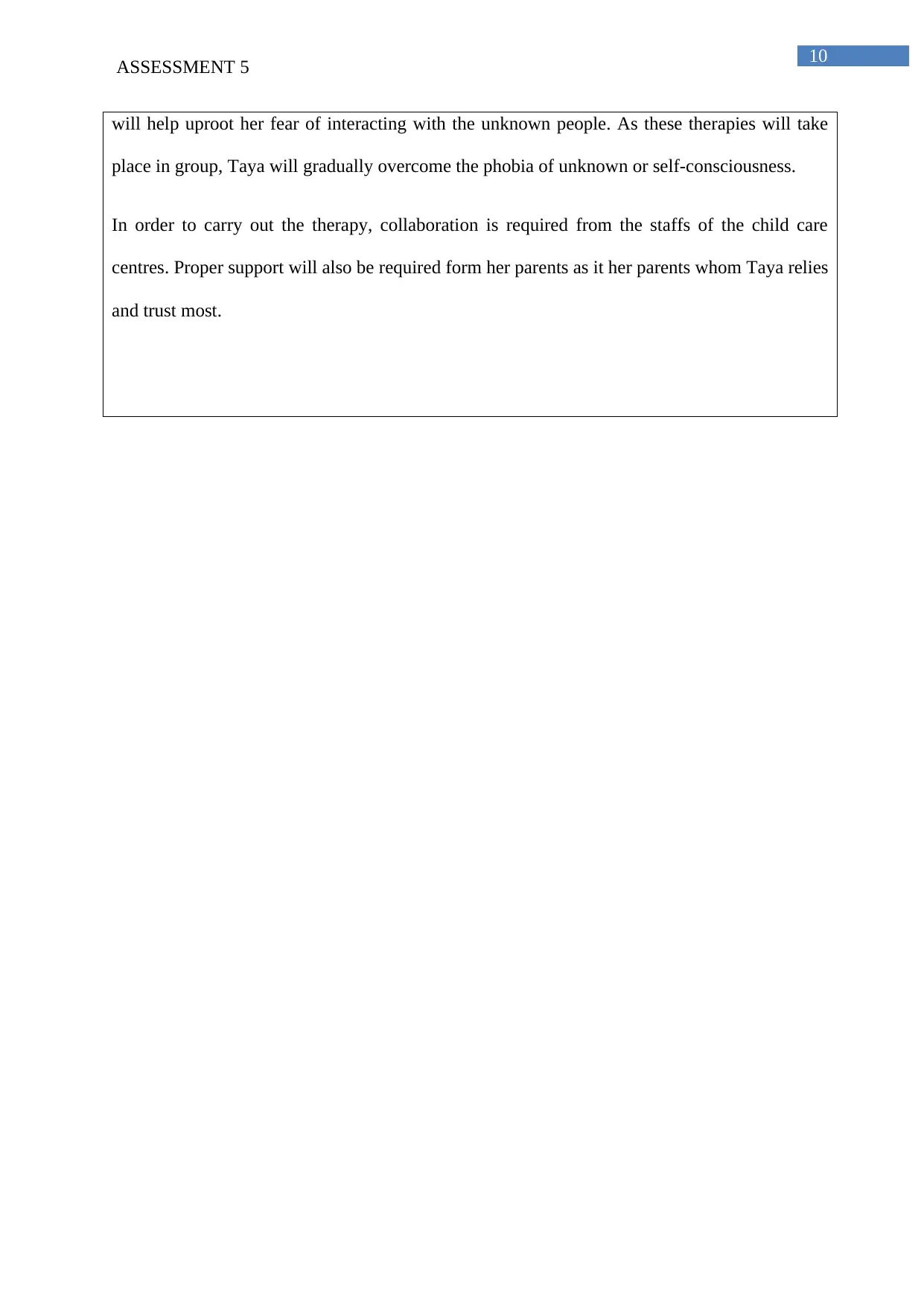
10
ASSESSMENT 5
will help uproot her fear of interacting with the unknown people. As these therapies will take
place in group, Taya will gradually overcome the phobia of unknown or self-consciousness.
In order to carry out the therapy, collaboration is required from the staffs of the child care
centres. Proper support will also be required form her parents as it her parents whom Taya relies
and trust most.
ASSESSMENT 5
will help uproot her fear of interacting with the unknown people. As these therapies will take
place in group, Taya will gradually overcome the phobia of unknown or self-consciousness.
In order to carry out the therapy, collaboration is required from the staffs of the child care
centres. Proper support will also be required form her parents as it her parents whom Taya relies
and trust most.
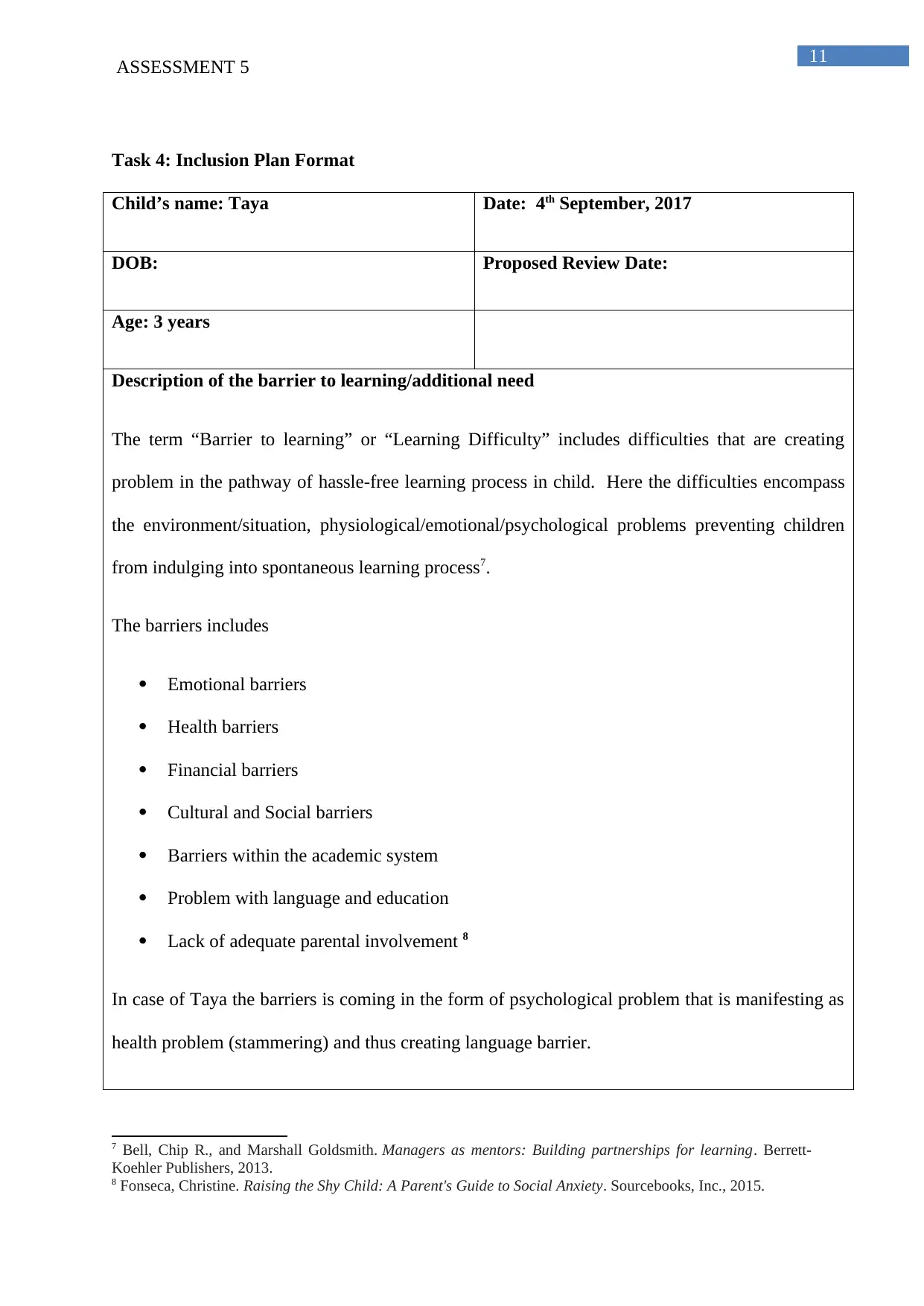
11
ASSESSMENT 5
Task 4: Inclusion Plan Format
Child’s name: Taya Date: 4th September, 2017
DOB: Proposed Review Date:
Age: 3 years
Description of the barrier to learning/additional need
The term “Barrier to learning” or “Learning Difficulty” includes difficulties that are creating
problem in the pathway of hassle-free learning process in child. Here the difficulties encompass
the environment/situation, physiological/emotional/psychological problems preventing children
from indulging into spontaneous learning process7.
The barriers includes
Emotional barriers
Health barriers
Financial barriers
Cultural and Social barriers
Barriers within the academic system
Problem with language and education
Lack of adequate parental involvement 8
In case of Taya the barriers is coming in the form of psychological problem that is manifesting as
health problem (stammering) and thus creating language barrier.
7 Bell, Chip R., and Marshall Goldsmith. Managers as mentors: Building partnerships for learning. Berrett-
Koehler Publishers, 2013.
8 Fonseca, Christine. Raising the Shy Child: A Parent's Guide to Social Anxiety. Sourcebooks, Inc., 2015.
ASSESSMENT 5
Task 4: Inclusion Plan Format
Child’s name: Taya Date: 4th September, 2017
DOB: Proposed Review Date:
Age: 3 years
Description of the barrier to learning/additional need
The term “Barrier to learning” or “Learning Difficulty” includes difficulties that are creating
problem in the pathway of hassle-free learning process in child. Here the difficulties encompass
the environment/situation, physiological/emotional/psychological problems preventing children
from indulging into spontaneous learning process7.
The barriers includes
Emotional barriers
Health barriers
Financial barriers
Cultural and Social barriers
Barriers within the academic system
Problem with language and education
Lack of adequate parental involvement 8
In case of Taya the barriers is coming in the form of psychological problem that is manifesting as
health problem (stammering) and thus creating language barrier.
7 Bell, Chip R., and Marshall Goldsmith. Managers as mentors: Building partnerships for learning. Berrett-
Koehler Publishers, 2013.
8 Fonseca, Christine. Raising the Shy Child: A Parent's Guide to Social Anxiety. Sourcebooks, Inc., 2015.
⊘ This is a preview!⊘
Do you want full access?
Subscribe today to unlock all pages.

Trusted by 1+ million students worldwide
1 out of 17
Your All-in-One AI-Powered Toolkit for Academic Success.
+13062052269
info@desklib.com
Available 24*7 on WhatsApp / Email
![[object Object]](/_next/static/media/star-bottom.7253800d.svg)
Unlock your academic potential
Copyright © 2020–2025 A2Z Services. All Rights Reserved. Developed and managed by ZUCOL.


